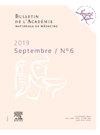支气管肺癌的现状:医学治疗
IF 0.3
4区 医学
Q3 MEDICINE, GENERAL & INTERNAL
引用次数: 0
摘要
在法国和西方世界,支气管肺癌(CBPs)是癌症死亡的主要原因。虽然整体预后依然惨淡,与标准化净存活率为20%至5岁时,他已经彻底改变了,至于非小细胞癌(CBNPC),通过有针对性的治疗出现15%的患者来说,从不吸烟吸烟者(空气污染)、小角色或断奶ex-fumeurs十年多以来,其中载有致癌突变的肿瘤上瘾(EGFR、ALK),无论是在转移情况,局部或局部先进,单独或与局部区域治疗(手术或放疗)联合。出现抗性分子机制,更好的理解,设计了抑制剂的第二、第三和第4代,现在第一或第二行或替代策略,基于bi-spécifiques抗体,通常口服化疗或者靶向抑制剂结合,所有这些第三代线的连续治疗,导致生存很长了好几年的转移情况,在本世纪初,单靠化疗的平均存活率只有12个月。大多数患者,通常是重度吸烟者,他们的肿瘤没有成瘾性突变,从免疫疗法中受益,抗体针对免疫抗肿瘤反应的抑制控制点,单独或与化疗联合使用。同样,20 - 40%的患者有完全或接近完全的反应,存活率可达5年或更长时间,其中一些患者虽然最初转移,但有可能治愈。不同免疫治疗抗体或结合抗体的组合正在开发中,至少对其中一部分患者来说,10年生存目标似乎不再是乌托邦式的,就像在转移性黑色素瘤患者中报道的那样。非小细胞肺癌(NSCLC)是法国和西方世界癌症死亡的主要原因。While their整体而言预后遗骨小菜,with a标准化净脾of 20% 5 years at their生存预后has been revolutionized by the涌现of目标治疗法for 15%患者of who are never smokers作用》(空气污染)、黄金(small ex-smokers smokers who have quitted for more than 10 years,别上瘾肿瘤含有每年oncogenic (EGFR、ALK突变),如果metastatic localized locally advanced黄金,单独治疗或与局部治疗(手术或放疗)联合治疗。分子耐药机制的出现,越来越多地被理解,允许设计第二代、第三代和现在的第四代抑制剂,或基于双特异性抗体的替代一线或二线策略,通常与化疗联合使用,或与第三代口服靶向抑制剂。这些连续的治疗路线加在一起,导致了非常长的生存率,即使在转移的情况下,而在本世纪初,铂基化疗只提供了12个月的平均生存率。这是一种非常有效的治疗方法,可以让你的身体恢复正常,让你的身体恢复正常。同样,20 - 40%的患者有完全或接近完全的反应,存活率为5年或更长时间,其中一些患者虽然最初转移,但存在潜在治疗的问题。目前正在开发不同免疫治疗抗体或结合抗体的组合,使新的10年生存前沿不再是空想,至少对这些患者的一部分来说,正如在转移性黑色素瘤患者中所报道的那样。本文章由计算机程序翻译,如有差异,请以英文原文为准。
Actualités dans le cancer broncho-pulmonaire : traitements médicaux
Les cancers broncho-pulmonaires (CBP) constituent la première de cause mortalité par cancer en France et dans le monde occidental. Si leur pronostic global reste sombre, avec un taux de survie net standardisé de 20 % à 5 ans, il a été révolutionné, en ce qui concerne les cancers non à petites cellules (CBNPC), par l’émergence des thérapeutiques ciblées pour 15 % des patients, jamais fumeurs (rôle de la pollution atmosphérique), petits fumeurs ou ex-fumeurs sevrés depuis plus de 10 ans, dont la tumeur contient une mutation oncogénique addictive (EGFR, ALK), que ce soit en situation métastatique, localisée ou localement avancée, seules ou en association avec des traitements locorégionaux (chirurgie ou radiothérapie), respectivement. L’émergence de mécanismes moléculaires de résistance, de mieux en mieux compris, a permis la conception d’inhibiteurs de 2e, 3e et désormais 4e génération, ou de stratégies alternatives de première ou deuxième ligne, basées sur des anticorps bi-spécifiques, souvent en association à chimiothérapie ou un inhibiteur ciblé oral de 3e génération, l’ensemble de ces lignes thérapeutiques successives aboutissant à des survies très prolongées de plusieurs années en situation métastatique, là où la seule chimiothérapie n’offrait, en début de siècle, qu’une médiane de 12 mois de survie. La majorité des patients, souvent gros fumeurs, dont la tumeur est dépourvue de mutation addictive, bénéficient quant à eux des immunothérapies, ces anticorps ciblant les points de contrôle inhibiteurs de la réponse immune anti-tumorale, seuls ou en association avec la chimiothérapie. Là encore 20 à 40 % de ces patients ont des réponses complètes ou quasi-complètes, avec des survies atteignant 5 ans ou plus, avec pour certains, pourtant initialement métastatiques, la question d’une potentielle guérison. Des associations de différents anticorps d’immunothérapies ou anticorps conjugués sont en développement, des objectifs survie à 10 ans, qui ne paraissent plus utopiques, au moins pour une fraction de ces patients, à l’instar de ce qui a été rapporté pour les patients avec mélanome métastatique.
Non-small cell lung cancers (NSCLC) are the leading cause of cancer mortality in France and the Western world. While their overall prognosis remains poor, with a standardised net survival rate of 20% at 5 years, their prognosis has been revolutionized by the emergence of targeted therapies for 15% of patients who are never smokers (role of air pollution), small or ex-smokers, smokers who have quitted for more than 10 years, whose tumours contain an addictive oncogenic mutation (EGFR, ALK), whether metastatic, localized or locally advanced, alone or in combination with loco-regional treatments (surgery or radiotherapy), respectively. The emergence of molecular resistance mechanisms, increasingly understood, has allowed the design of 2nd, 3rd and now 4th generation inhibitors, or alternative first or second line strategies based on bi-specific antibodies, often in combination with chemotherapy, or with an oral 3rd generation targeted inhibitor. Together these successive therapeutic lines have lead to very prolonged survival of several years, even in metastatic situation, whereas the platinum-based chemotherapy only offered, at the beginning of the century, a median of 12 months survival. The majority of patients, often heavy smokers, whose tumour is devoid of addictive mutations, now benefit from immunotherapies, antibodies targeting the checkpoints inhibiting the anti-cancer immune response, alone or in combination with chemotherapy. Again, 20 to 40% of these patients have complete or almost complete responses, with survivals of 5 years or more, with for some, although initially metastatic, the issue of a potential cure. Combinations of different immunotherapy antibodies or conjugated antibodies are being developed, making the new 10-year survival frontier no longer utopian, at least for a fraction of these patients, as it has been reported for patients with metastatic melanoma.
求助全文
通过发布文献求助,成功后即可免费获取论文全文。
去求助
来源期刊
CiteScore
0.50
自引率
33.30%
发文量
189
审稿时长
47 days
期刊介绍:
Rédigé par des spécialistes à l''intention d''une Communauté pluridisciplinaire le Bulletin de l''Académie nationale de médecine est au service de toutes les professions médicales : médecins, pharmaciens, biologistes et vétérinaires ainsi que de l''Administration et des institutions intervenant dans le domaine de la santé.
Les mémoires originaux et les mises au point sur des thèmes d''actualité sont associés au compte rendu des discussions qui ont suivi leur présentation. Les rapports des commissions sur l''éthique médicale l''exercice de la profession les questions hospitalières la politique du médicament et l''enseignement de la médecine justifient les recommandations de l''Académie.

 求助内容:
求助内容: 应助结果提醒方式:
应助结果提醒方式:


